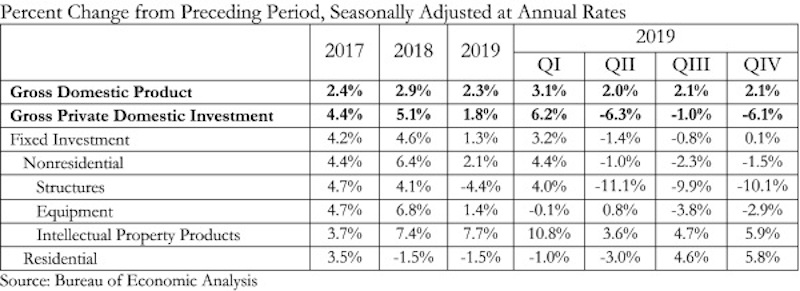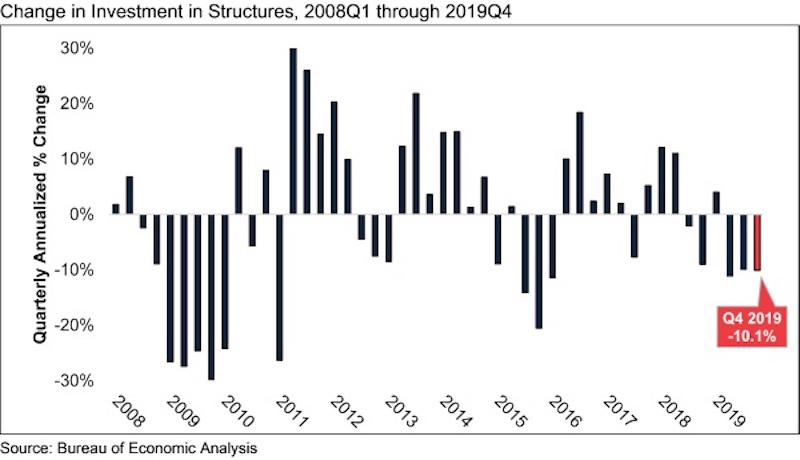The U.S. economy expanded at an annualized rate of 2.1% in the fourth quarter of 2019, despite investment in structures declining at an annualized rate of 10.1%, according to an Associated Builders and Contractors analysis of data released today by the U.S. Bureau of Economic Analysis. Investment in structures contracted for three consecutive quarters and declined 4.4% during 2019.
In 2019, real GDP expanded by 2.3%, which was slower than the 2.9% rate of growth observed in 2018. Investment in structures contracted 4.4% in 2019 after expanding by 4.1% in 2018.
“Last year will be remembered as decent but unspectacular for the U.S. economy,” said ABC Chief Economist Anirban Basu. “Strong consumer spending, historically low unemployment, surging asset prices and healthy backlog levels, according to ABC’s Construction Backlog Indicator, were offset by soft business investment, flattening levels of nonresidential construction and soaring national debt. In addition, key segments of the economy, including manufacturing and agriculture, were particularly weak.
“But 2019 tells us little about 2020 dynamics,” said Basu. “Coming into last year, many expected interest rates and the general cost of capital to rise. Instead, interest rates dipped, creating an improved environment for purchasers of construction services. Last year was also shrouded by fears of worsening trade wars, but with the ratification of the USMCA and the attainment of a first phase trade deal with China, the level of uncertainty has abated. Through the first month of 2020, this has translated into rising stock prices, which should induce greater business investment.
“This year’s presidential election may cause some purchasers of construction services to adopt a wait-and-see attitude,” said Basu. “Contractors are currently upbeat about their prospects over the next two quarters, according to ABC’s Construction Confidence Index. However, given contracting levels of investment in structures, it is unclear if that will persist through the end of 2020.”


Related Stories
Market Data | Mar 29, 2017
Contractor confidence ends 2016 down but still in positive territory
Although all three diffusion indices in the survey fell by more than five points they remain well above the threshold of 50, which signals that construction activity will continue to be one of the few significant drivers of economic growth.
Market Data | Mar 24, 2017
These are the most and least innovative states for 2017
Connecticut, Virginia, and Maryland are all in the top 10 most innovative states, but none of them were able to claim the number one spot.
Market Data | Mar 22, 2017
After a strong year, construction industry anxious about Washington’s proposed policy shifts
Impacts on labor and materials costs at issue, according to latest JLL report.
Market Data | Mar 22, 2017
Architecture Billings Index rebounds into positive territory
Business conditions projected to solidify moving into the spring and summer.
Market Data | Mar 15, 2017
ABC's Construction Backlog Indicator fell to end 2016
Contractors in each segment surveyed all saw lower backlog during the fourth quarter, with firms in the heavy industrial segment experiencing the largest drop.
Market Data | Feb 28, 2017
Leopardo’s 2017 Construction Economics Report shows year-over-year construction spending increase of 4.2%
The pace of growth was slower than in 2015, however.
Market Data | Feb 23, 2017
Entering 2017, architecture billings slip modestly
Despite minor slowdown in overall billings, commercial/ industrial and institutional sectors post strongest gains in over 12 months.
Market Data | Feb 16, 2017
How does your hospital stack up? Grumman/Butkus Associates 2016 Hospital Benchmarking Survey
Report examines electricity, fossil fuel, water/sewer, and carbon footprint.
Market Data | Feb 1, 2017
Nonresidential spending falters slightly to end 2016
Nonresidential spending decreased from $713.1 billion in November to $708.2 billion in December.
Market Data | Jan 31, 2017
AIA foresees nonres building spending increasing, but at a slower pace than in 2016
Expects another double-digit growth year for office construction, but a more modest uptick for health-related building.

















